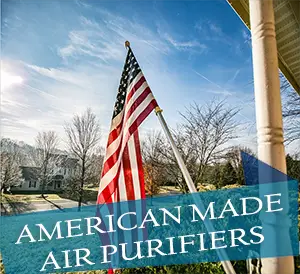
If you haven’t decided yet on which air purifier to buy amidst a highly-polluted home or community, we’d like to help you out. In this article, we’ll give you some advice on how to choose the best one for your needs.
Air purifiers are not simply home gadgets that waste money – they do something: clean the air you breathe. Thanks to their filters, known as the HEPA or sometimes true HEPA filter, along with their pre-filter and activated carbon for bad smells, they can target most pollution in your home and ones that come from outside, such as dust, dirt, and pollen.
This is why we’d like to show you some of our suggested picks, as well as tips on buying the best air purifier for your home, office, or any other use.
Are air purifiers a waste of money?
No, they’re not! Air purifiers have been proven by science time and time again due to their powerful filters. Let’s explain these filters in simple layman terms:
| HEPA or true HEPA filter | The HEPA or high-efficiency particulate absorbing filter is the very heart of an air purifier. It can trap up to 99.97% of pollen, dust, dirt, pet dander, and the like. |
| Activated carbon | Do air purifiers help with smell? Yes, they do! Thanks to the activated carbon filter, it can get rid of smoke, VOCs, and other bad odor such as mold. |
| Pre-filter | The pre-filter can trap the larger particles that are circulating the air, such as large, visible dust. This is why they are usually reusable and can be cleaned, unlike HEPA filters that need to be replaced. |
| UV-C sanitizer | A UV-C sanitizer can be present in some air purifiers. They can disinfect certain bacteria and viruses, as well as mold spores through UV light. |
Do home air purifiers really work?
Yes! Air purifiers can really work to help minimize the pollution in your air. As we mentioned above, the combination of the true HEPA filter, activated carbon, and the like can help clean up your indoor air.
However, you should make sure that the air purifier is rated for the right room size to be efficient. You also need to wait a little longer for it to work and you should also have added ventilation such as an A/C unit to help the air circulate.
Who makes the best room air purifier?
Based on our experience, the best air purifiers come from LEVOIT, Honeywell, and Germ Guardian: their air purifiers are well-rated and work. Most of them also have filters that are easily available from the market so you don’t have to fuss with buying them.

Other than those two brands, you can also check out brands such as Winix, Coway, and Blueair. They all have affordable air purifiers as well as the whole-house type or an air purifier for large space.
What is the best air purifier to buy?
If you’re still searching for a good air purifier to buy, we have some suggested picks for you:

Winix 5500-2 Air Purifier – we picked this one if you want a kitchen air purifier. It has the following:
- Rated for 360 square feet. This means that you can use it for small to medium-sized rooms.
- Washable AOC Carbon Filter. The carbon filter can help eliminate VOCs and other bad smells from your home.
- As low as 27.8 dB. This level of noise means that it is not that loud for those who are frequently disturbed by loud motor noises.
- True HEPA filter. This can trap most allergens from the air and can be easily changed when it’s fully used.

Honeywell HPA300 True HEPA Air Purifier – for bedrooms, this one could be for you since it doesn’t take a lot of space:
- Up to 465 Square Feet. This means that it can be used for medium-sized rooms, such as bedrooms and kids’ rooms.
- 3 air cleaning levels. This allows you to adjust the cleaning level depending on how severe the air quality is in your indoor space.
- Turbo Clean setting. For allergy seasons such as hay fever, the turbo clean setting can be a helpful mode for them.
- 5-year warranty. This can give you peace of mind overall, as it is usually a longer warranty period than most air purifiers.

Coway AP-1512HH Mighty Air Purifier – if you want an air purifier for the living room, you might find this aesthetically pleasing:
- Brightly colored LED. It can also act as a light but most importantly, it can show the air quality of your indoor space in real-time.
- Up to 361 sq. ft. This means it applies to small to medium-sized rooms.
- 3 fan speeds. You can adjust depending on whether you need full power against the pollution in your home.
- Up to 8 hours for its timer. For those who need it for their bedroom, this can be a helpful feature without wasting electric consumption.

Germ Guardian AC4825W Air Purifier for Home – we picked this one for those who are suffering from allergies and asthma:
- UV-C light. This one can disinfect your indoor areas, especially if your home is prone to mold and mildew due to the humidity.
- 3-speed settings. This allows you to adjust when the air quality is really bad.
- Quiet operation. Those who are light sleepers won’t have to worry about the air purifier’s background noise.
- Slim design. The tower design allows it to fit even in small corners of the house. This design also allows it to distribute its air-cleaning properties faster.
 Blueair Classic 205 Air Purifier is our ideal choice. We think it’s best because of:
Blueair Classic 205 Air Purifier is our ideal choice. We think it’s best because of:
a) True HEPA filter. As most of you may be aware, a true HEPA filter means that it can trap up to 99.97% of particles in the air, which includes pet dander, dust, pollen, allergens, and much more. This can efficiently clean your air much more than having to dust it or wipe off surfaces. This would also be an advantage to those who have allergic rhinitis or hay fever, as well as those with frequent asthma attacks.
- b) Low noise levels. At only 32 dB to 56 dB, this one can be best for those who cannot sleep easily with motor noises. Therefore, you may need an air purifier that works well for the noise levels even when its power or fan speed is at its highest.
Furthermore, a low noise level also means that your unit isn’t overheating that much. This can also significantly lengthen the lifespan of your motor, resulting in less likelihood of your unit getting broken quickly (and having to worry about that warranty period).
- c) Smoke filters. A smoke filter is present in this unit, which makes it ideal for those who are frequently cooking fish or having smokers in the family (or guests, for that matter). Secondhand smoke is one of the leading causes of health problems and that’s why having smoke filters can be helpful.
- d) Wi-Fi enabled and Amazon Alexa compatible. We liked the fact that this unit can be switched on and off using Amazon Alexa, which might fit in your modern living space, or if your office already uses this kind of system.
- e) Ideal for small rooms. If your room or area is anywhere around 279 feet, this may be a decent air purifier for you with its power. It’s not too much in terms of power consumption as well.
- f) 3 fan speeds. These different fan speeds allow you to customize depending on the air quality in your home, which can help to minimize the usage and power consumption of your air purifier.
What is the best small room air purifier?

For small rooms, we’d recommend the Honeywell True, which is rated for up to 465 square feet of rooms. As a trusted brand, Honeywell’s 9-month lifespan filter can mean that you can change it less often. It’s also backed with an auto-resume feature so if ever there’s a power interruption, you can just worry less about having to turn it back on.
Where should I place my air purifier?
Here are some ideal places as to where to put your air purifier in order to get the most out of it:
- On walls. If you can place it, most air purifiers that can be stuck on walls deserve to be there. This is because most odors do stick on walls, and one way to fight it is to put one air purifier on the wall. If your home suffers from kitchen odors, putting an air purifier on your wall may be a good trick.
- Near vent areas. Consider areas with windows or vent units, as this is where the majority of the air comes from. When your air purifier filters the incoming air, the result is fresh and clean air to breathe.
- Accessible areas. Don’t put them in corners where their efficiency might be blocked. Instead, put them on higher areas so that they can be able to circulate the air and effectively clean it. Think of how you would place an AC unit on a much accessible area instead of a closed one.
What is the best affordable air purifier?

The Bissell air400 Air Purifier may be a choice for you if you’re limited on budget. Like most air purifiers, it also has a true HEPA filter and uses a 3-stage filtration system to fight not only pollution and dust but also odors in the house (due to the included activated carbon).
For its price, you can even use it for medium-sized rooms, as it’s rated for 300 to 400 square feet while its lowest noise is at 30 dBA – ideal for light sleepers or apartment/condo unit dwellers.
If you want to find out more, our best-rated air purifiers buyer guide can help you decide on different brands and models depending on your needs.
What is the best quiet air purifier?
For those who can’t sleep properly due to a noisy unit, you might like the LEVOIT LV-H133 Air Purifier. It only runs at 25 dB so if you’re a light sleeper, this might be for you. Thanks to its circular design, it can cover the whole room while it doesn’t make that much of a buzzing motor sound. It’s even ideal for medium to large rooms up to 538 square feet.
LEVOIT LV-H133 Air Purifier. It only runs at 25 dB so if you’re a light sleeper, this might be for you. Thanks to its circular design, it can cover the whole room while it doesn’t make that much of a buzzing motor sound. It’s even ideal for medium to large rooms up to 538 square feet.
Aside from using a true HEPA filter, it even complies with the CARB, FCC, and ETL for safety certificates. The unit even has a compact design so it’s easy to place anywhere in your room or office.
Conclusion
In the long run, if you’re debating on what air purifier model or brand to buy, all you need to do is to examine its specs and find out which one is best for your needs depending on the room size, air quality, and other factors.
Having bad air quality can affect your health, and this is why we are concerned about your well-being, so we wrote this article. Hope you enjoyed it and learned something!


